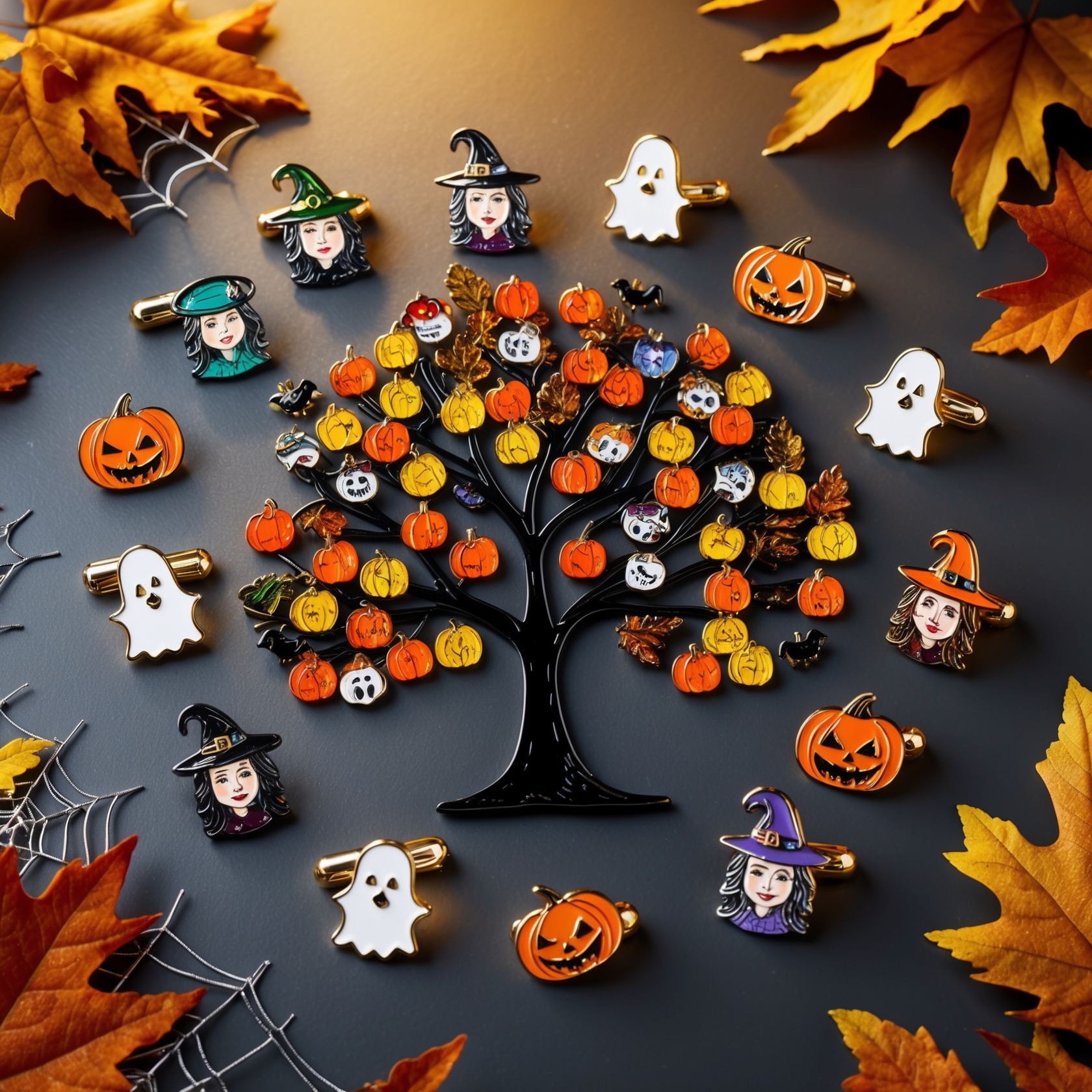In the world of accessories, few items can rival the understated elegance and versatility of custom lapel pins. These small but meaningful adornments have been used for centuries to convey messages, represent affiliations, commemorate events, and serve as tokens of recognition. From their origins as practical fasteners to their evolution into symbols of status, pride, and achievement, custom lapel pins have played a significant role in human history.
The journey of custom lapel pins spans many centuries and touches various cultures, from ancient civilizations to modern political movements, military organizations, and fashion trends. Today, lapel pins are used by businesses, organizations, and individuals alike to express identity, celebrate achievements, and honor traditions.
In this article, we will take a journey through time to explore the evolution and historical significance of custom lapel pins. We will trace their origins, examine their roles across different eras and societies, and discuss how they have become a vital part of modern culture. Whether used for military decoration, political expression, or fashion, custom lapel pins have proven to be a powerful and enduring symbol.
The Origins of Lapel Pins: From Practical to Symbolic
The history of lapel pins is deeply intertwined with the history of brooches and pins, which were originally used for practical purposes. In ancient civilizations, pins and brooches served as functional fasteners for clothing. For instance, the ancient Greeks and Romans used fibulae (a type of brooch) to hold together garments such as togas and tunics. These fibulae were often elaborately designed and crafted from precious metals, serving both a practical and decorative function.
As clothing evolved and garments became more tailored, the need for functional fasteners diminished. However, the decorative nature of these pins and brooches persisted, and they gradually evolved into symbols of status and identity. By the Middle Ages, brooches and pins were often used to denote social rank, wealth, or allegiance to a noble house.
It wasn’t until the 19th century, during the Victorian era, that lapel pins began to emerge in the form we recognize today. With the rise of men’s tailored suits and jackets, lapels became a prominent feature of formal attire. Lapel pins, often adorned with flowers or symbolic motifs, became fashionable accessories that could be worn to add a personal touch to an outfit. During this time, custom lapel pins began to appear, often featuring monograms, family crests, or symbols of professional or fraternal organizations.
Lapel Pins and Military Decoration: A Symbol of Honor
One of the most significant roles custom lapel pins have played throughout history is in military decoration. Lapel pins and medals have long been used by military organizations to honor service, bravery, and sacrifice. These pins are often highly symbolic, featuring national emblems, regimental insignia, and other imagery that reflects the values of the military.
1. The Emergence of Military Lapel Pins
The use of pins as military decoration dates back to ancient times, but the modern tradition of awarding military lapel pins began in the 18th and 19th centuries. During this period, many nations began to formalize military honors by creating orders of merit, distinguished service medals, and other awards that could be worn on uniforms.
For example, the French Legion of Honor, established by Napoleon Bonaparte in 1802, is one of the oldest and most prestigious military awards in the world. Recipients of this honor wear a medal featuring a five-armed cross on a red ribbon, often displayed as a lapel pin. Similarly, the United Kingdom’s Victoria Cross, established in 1856, honors acts of extraordinary bravery in combat and is worn as a pin or ribbon on military uniforms.
In the United States, custom lapel pins have been used to recognize military service since the Civil War. Soldiers were awarded pins for acts of valor, such as the Medal of Honor, which is the highest military decoration in the U.S. military. These military pins are often worn on formal military uniforms as symbols of courage, service, and sacrifice.
2. Military Pins in World War I and World War II
During World War I and World War II, lapel pins became even more significant as symbols of military service and patriotism. Soldiers and veterans proudly wore lapel pins to signify their service, and families often displayed service pins on their clothing to honor loved ones who were serving in the armed forces.
In addition to military honors, custom lapel pins were used during these wars to promote national unity and raise awareness for various war efforts. For example, during World War I, the American Red Cross distributed lapel pins to donors who contributed to war relief efforts. These pins often featured the iconic red cross emblem and were worn as badges of honor by civilians who supported the war effort.
By World War II, the use of custom lapel pins had expanded even further. Military units and divisions created their own insignia, which were worn as lapel pins to foster camaraderie and unit pride. Lapel pins featuring national flags, eagles, and other patriotic symbols became popular among both military personnel and civilians, reinforcing a sense of national solidarity during the war.
Custom Lapel Pins in Political and Social Movements
While custom lapel pins have a long history in the military, they have also played a crucial role in political and social movements. From political campaigns to grassroots activism, lapel pins have been used to convey powerful messages, express solidarity, and rally support for causes.
1. Political Lapel Pins: Symbols of Loyalty and Support
One of the earliest uses of custom lapel pins in politics can be traced back to the 19th century in the United States, when political campaigns began producing pins and badges to promote candidates. These pins often featured the images or slogans of presidential candidates and were worn by supporters to demonstrate their loyalty and enthusiasm for the campaign.
For example, during the 1860 U.S. presidential election, supporters of Abraham Lincoln wore lapel pins featuring his portrait to show their allegiance. This practice became more widespread in the following decades, with campaign pins becoming a staple of American political life.
In the 20th century, political lapel pins became even more prominent. Candidates and political parties began producing custom lapel pins en masse as part of their campaign merchandise, offering supporters an easy way to show their political leanings. These pins often featured slogans such as “I Like Ike” (in support of Dwight D. Eisenhower’s presidential campaign) or “Make America Great Again” (in support of Donald Trump’s campaign).
2. Lapel Pins in Social Movements: A Badge of Solidarity
In addition to political campaigns, custom lapel pins have been instrumental in social movements. Activists and advocacy groups have long used lapel pins to spread awareness of their causes and show solidarity with marginalized communities. These pins serve as visual representations of the values and goals of social movements, helping to unify supporters and increase visibility for their causes.
One notable example is the use of custom lapel pins during the civil rights movement in the 1960s. Activists fighting for racial equality and justice often wore lapel pins featuring symbols like the raised fist, which became an iconic symbol of resistance and solidarity. These pins allowed supporters to quietly but powerfully show their commitment to the cause, even in the face of opposition.
Similarly, the LGBTQ+ rights movement has used custom lapel pins as a means of expressing pride and advocating for equality. Rainbow-colored pins, which represent the LGBTQ+ community, have become widely recognized symbols of inclusivity and support. These pins are worn by both members of the LGBTQ+ community and allies, serving as a badge of solidarity and a call for equal rights.
Today, custom lapel pins continue to be used in social and political movements, with activists creating pins that represent everything from environmental sustainability to gender equality. These pins act as both personal statements and public declarations, giving wearers a way to visibly support the causes they believe in.
Fashion and Lapel Pins: A Symbol of Style and Individuality
While custom lapel pins have served practical, military, and political purposes throughout history, they have also evolved into fashion accessories that allow individuals to express their personal style and individuality. Over the years, lapel pins have become a staple in men’s and women’s fashion, adding flair and elegance to everything from formal attire to casual outfits.
1. Lapel Pins in Formal Fashion
Lapel pins have long been associated with formal fashion, particularly in the world of men’s suits and jackets. In the early 20th century, as men’s fashion became more tailored and sophisticated, lapel pins emerged as a way to personalize an otherwise uniform outfit. Gentlemen often wore floral lapel pins or boutonnières (fresh or fabric flowers) as part of their formal attire, adding a touch of elegance and color to their lapels.
Over time, custom lapel pins became a popular alternative to flowers, allowing wearers to choose from a wide variety of designs, from monograms and family crests to symbols of professional associations. These pins became an integral part of men’s formal wear, particularly for weddings, gala events, and other special occasions.
Today, lapel pins remain a key accessory in men’s formal fashion, with designers creating custom lapel pins that range from minimalist designs to intricate, bejeweled creations. They can be worn on suits, tuxedos, blazers, and jackets, adding a personal touch to formal attire while showcasing the wearer’s style and personality.
2. Lapel Pins in Casual and Streetwear Fashion
In recent years, custom lapel pins have made their way into casual and streetwear fashion, becoming a popular accessory among younger generations. Lapel pins are no longer limited to formal events—they are now worn on denim jackets, backpacks, hats, and even sneakers, adding a playful and creative element to everyday outfits.
Streetwear designers and independent artists have embraced lapel pins as a canvas for creativity, producing pins that feature bold, eye-catching designs, pop culture references, and artistic motifs. These pins often reflect the interests and identities of the wearers, allowing them to showcase their favorite music, movies, hobbies, or personal beliefs through their clothing.
For many, custom lapel pins in casual fashion serve as a form of self-expression, offering a way to make a statement without saying a word. Whether it’s a pin featuring a favorite band, a political message, or a whimsical design, these accessories allow individuals to curate their own personal style in a unique and meaningful way.
Modern Uses of Custom Lapel Pins: From Branding to Commemoration
In today’s world, custom lapel pins continue to serve a wide range of purposes, from branding and marketing to commemoration and recognition. Businesses, organizations, and individuals use lapel pins as versatile tools for promoting their message, celebrating milestones, and building a sense of community.
1. Custom Lapel Pins for Branding and Marketing
Many businesses and organizations use custom lapel pins as part of their branding and marketing strategies. These pins are often created with the company’s logo, slogan, or mascot and are distributed at events, trade shows, or as part of promotional campaigns. Lapel pins are small, portable, and highly visible, making them an ideal way to promote brand recognition and loyalty.
For example, tech companies might create custom lapel pins featuring their logo to distribute to employees and customers at product launches or corporate events. Similarly, nonprofits often produce pins with their mission statement or emblem to raise awareness for their cause and encourage support from donors.
Lapel pins also serve as a way for employees to show pride in their organization. Many companies create pins for employees to wear on their uniforms or business attire, reinforcing a sense of belonging and loyalty within the workforce.
2. Lapel Pins for Commemoration and Recognition
Lapel pins are also widely used to commemorate special events, milestones, and achievements. From celebrating anniversaries and retirements to recognizing volunteer work and leadership, custom lapel pins provide a meaningful way to honor individuals and mark important occasions.
For example, schools often create custom lapel pins to commemorate graduation ceremonies, allowing students to wear pins that symbolize their academic accomplishments. Similarly, companies may produce lapel pins to celebrate significant anniversaries or to recognize employees who have reached important career milestones.
In sports, lapel pins are frequently used to commemorate championships, tournaments, or team achievements. Athletes, coaches, and fans alike wear these pins as symbols of their participation and success in the event.
3. Lapel Pins in Community and Fundraising Efforts
In addition to their use in branding and recognition, custom lapel pins are often created as part of community and fundraising efforts. Many charitable organizations produce lapel pins that represent their cause and distribute them to donors, volunteers, and supporters as a way of saying thank you and raising awareness.
For instance, pink ribbon lapel pins are widely recognized symbols of breast cancer awareness, while red ribbon pins represent support for HIV/AIDS awareness. These pins serve as both fundraising tools and visual reminders of the cause they represent, helping to spread awareness and foster a sense of community among those who wear them.
The Craftsmanship Behind Custom Lapel Pins
While lapel pins may be small, the craftsmanship behind their design and production is a testament to the artistry and attention to detail involved in creating these accessories. From the choice of materials to the intricacies of the design, every aspect of a custom lapel pin contributes to its overall impact and significance.
1. Materials and Techniques
Lapel pins can be made from a variety of materials, including metals such as brass, copper, and stainless steel, as well as enamel, acrylic, and even wood. Metal pins are often plated with gold, silver, or nickel to achieve a polished, professional finish, while enamel pins feature colorful designs that are coated with a protective layer to prevent wear and tear.
The production process for custom lapel pins typically involves die-casting or stamping the design onto the chosen material, followed by cutting, polishing, and adding any desired finishing touches, such as paint or engraving. The craftsmanship involved in producing these pins ensures that they are durable and visually appealing, making them suitable for a wide range of purposes, from formal events to everyday wear.
2. Designing Custom Lapel Pins
The design process for custom lapel pins is a collaborative effort between the client and the manufacturer. Whether the pin is meant to represent a business, organization, or personal achievement, the design must capture the essence of the message or identity it represents. This often involves selecting appropriate symbols, logos, text, and color schemes that align with the purpose of the pin.
For example, a lapel pin designed to commemorate a corporate anniversary might feature the company’s logo alongside the number of years in operation, while a lapel pin created for a nonprofit organization might incorporate symbols that reflect the organization’s mission and values.
Once the design is finalized, the pin is produced with precision to ensure that every detail is captured. The end result is a custom lapel pin that not only looks great but also carries a deep sense of meaning for those who wear it.
The Enduring Legacy of Custom Lapel Pins
From their origins as practical clothing fasteners to their modern roles as symbols of honor, identity, and expression, custom lapel pins have a rich and varied history. Over the centuries, these small but significant accessories have evolved into powerful tools for communication, recognition, and celebration. They have been worn by soldiers, activists, politicians, and everyday individuals, each pin telling a unique story of service, pride, or personal belief.
Today, custom lapel pins continue to hold an important place in society, whether they are worn to honor military service, express political views, promote a brand, or commemorate a special event. As versatile symbols of human connection and achievement, lapel pins remind us of the enduring value of small gestures and the stories they tell.
As we look to the future, custom lapel pins will no doubt continue to evolve, adapting to new cultural trends, causes, and styles. But no matter how they change, these pins will remain timeless symbols of identity, pride, and tradition, weaving stories that span generations and touch lives around the world.
If you are interested in buying high quality custom lapel pins, you can call us at 866-246-9375 or fill out a FREE quote form.




